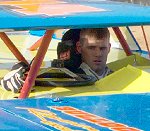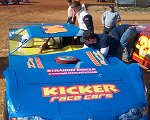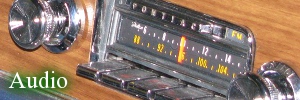|
By accessing or using The Crittenden Automotive Library™/CarsAndRacingStuff.com, you signify your agreement with the Terms of Use on our Legal Information page. Our Privacy Policy is also available there. |

Small-Town Dirt Track Racing
|
|---|
|
|
Small-Town Dirt Track Racing
Mike Osborne
May 19, 2002
 Listen to Small-Town Dirt Track Racing - RealPlayer - 695KB - 5:38
Listen to Small-Town Dirt Track Racing - RealPlayer - 695KB - 5:38

Open Wheel Modified teams on race day

Keith Denny's #48 car

Dirt car driver Tyrel Todd

Todd's #14 car
|
Americans spend so much time in their cars during the workweek, you'd think they'd want to escape all things automotive on the weekends. Instead, a growing number of them are devoting Saturdays and Sundays to watching or even competing in auto races, as reporter Mike Osborne discovered at a small town dirt track in Somerset, Kentucky.
The first race won't begin for hours yet, but teams from four states are already crowding the 400-meter track's infield and spilling over into the lot behind the stands.
The track is a short oval with a banked turn at each end. The racing surface is red clay dirt that's packed down to a hard, shiny surface. Spectators sit at the track edge, protected only by low cinder block walls and a chain link fence. Fans sitting on the turns are pelted with mud and small stones each time the cars pass.
At more than 100 kilometers per hour, the cars whip around the track so quickly they never get a chance to straighten up out of the turns. They look a bit like crabs scuttling down the track sideways. The inside front tire rarely touches the ground.
Most of the drivers are young men in their late teens and early twenties. The youngest competitor on the track is just twelve years old, and he won't be eligible for a license to drive on public roads for four more years. Driver Tyrel Todd, 21, is a six-year dirt track racing veteran. He says he'll hit the track several times trying to earn a spot in the night's featured race. "Well, first off, everybody starts out with 'hot-lapping', which is practice. You know, everybody gets five, six laps practice, get their car dialed in," he explains. "Then everybody comes in. Then everybody runs two laps of qualifying. They get your time, and out of that qualifying, you line your cars up in heat races. The top so many in each heat race will advance to the feature. The ones that do not advance will go on to a consolation race. That's kind of a 'last chance' race. So many in that race will go into the feature. Heat races are usually ten laps. The features, most places you go, are about 30 laps on a regular night."
Two different types of vehicles will compete. First, the "stock" racers - cars and trucks originally built for street driving, but modified for the racetrack. The second class of cars is called "modified" - vehicles built from the ground up specifically for dirt track racing. Tyrel Todd drives a modified that boasts three times the horsepower of most street vehicles. "The late model is, most of the time, the fastest class you'll find," he says. "They're really light cars, but they've still got pretty heavy engines with them. You know, a car only weighs [1000 kg], where a car on the road, you're more likely to see [1500 kg] you know, so they're a lot of horsepower with not much to handle it with."
There are no professionals here; most of the racing teams are formed around family groups or local businesses. The winning purse rarely exceeds $1,000. Keith Denny from Broadhead, Ketucky, explains it would be nearly impossible to make a living on the dirt tracks. "No, you'd have to win everything going," he says. "It's all in fun. It's a hobby, and it's all for fun. The more sponsors you've got, the better off you are, I mean, it helps. You can get between $12,000 and $20,000 in a modified easily."
American stock car legend Ned Jarrett began his career racing on dirt tracks all across the American south. Mr. Jarrett now provides radio commentary for the wildly popular NASCAR series of races. He says Americans love motor sports because driving is a shared experience. After all, nearly every family in the United States has at least one car.
"People do love their cars, have a lot of pride in their cars," he points out. "Race drivers are doing something that they do, and that is steering an automobile. They are driving it through turns, and driving it on straightaways, so you know, they are doing some of then same things."
Mr. Jarrett believes strongly that small town racing helps fuel American interest in motor sports of all types and is also a training ground for tomorrow's racing all-stars. "I have always felt that the experience that can be gained on dirt gives you what we call the 'seat of the pants' feeling of a racecar, better than asphalt," he says. "So if you can learn to drive on dirt and handle a car well, then usually the transition to asphalt is not that difficult, and the experience that you had on dirt can be very helpful to you."
While he gets that experience and dreams about racing professionally, Mike Brewer of Leslie County, Kentucky says he'll enjoy dirt track racing's camaraderie and competition. "You make a lot of friends out there, really, racing," he said. "You get someone you can run with, and in the end, everybody's still buddies. On the track you may have a little 'bumpin' or you may lose your temper, but afterwards, everybody's still friends. The guy that hit you in race four will help you fix your car in the next race. It's really a good environment. Something to bring your family to. I keep my kids there at the races and we all have a good time."


















 Topics: Lake Cumberland Speedway, Ned Jarrett
Topics: Lake Cumberland Speedway, Ned Jarrett
 Listen to Small-Town Dirt Track Racing - RealPlayer - 695KB - 5:38
Listen to Small-Town Dirt Track Racing - RealPlayer - 695KB - 5:38




